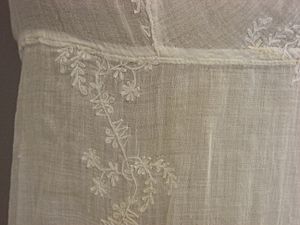Sewed muslin facts for kids
Sewed muslin was a popular style of clothing that came from Paris, France, in the late 1700s. It was a type of fancy needlework done on very thin muslin fabric. This style used many different stitches to create beautiful designs. These designs often showed flowers and plants, which is why it was also called flowered muslin. Sewed muslin is similar to a type of embroidery called tambour lace.
Contents
The Sewed Muslin Industry in Scotland
A very important person in the sewed muslin industry in Scotland was a woman known as Mrs Jamieson. She was married to a cotton agent in Ayrshire. Mrs. Jamieson saw a chance to help local people. She decided to teach the wives and daughters of farmers how to do this special needlework. She taught them how to use strong satin stitches, neat overcast fillings, and fine lace stitches in cut-out areas of the fabric.
How the Work Was Organized
The designs for the muslin were first drawn by professional artists in Glasgow. These designs were then sent out to people who worked from their homes. These home workers, mostly women and children, would then embroider the fabric. After the embroidery was finished, the muslin was cleaned and made into clothes or other items. Then, it was packaged and sold widely. Sewed muslin became very popular, especially in North America.
Impact on Scottish Workers
By 1791, this industry provided jobs for many people in Scotland. About 105,000 women and children worked in sewed muslin, often part-time. This was about 86% of all workers in Scotland at that time. The industry really helped the local communities. A minister in Houston, Renfrewshire, wrote in the 1790s that it allowed many young women to "not only maintain themselves, but to buy fineries." This meant they could earn their own money and even buy nice things for themselves.
Where the Muslin Came From
The fine muslin fabric used in this industry mostly came from local factories. The first cotton factories in west Scotland were built in the 1770s. By the 1780s, these factories were making very high-quality muslin. This was perfect for the demand for fine white muslins, which were very fashionable for the popular neo-classical style of dress.
Decline of the Industry
The Ayrshire whitework industry, which was a type of sewed muslin, became very successful. However, this success also led to its decline starting in the 1830s. In 1828, the first embroidery machine was invented and patented. This machine could create similar designs much faster and cheaper than people could by hand.
The popularity of sewed muslin continued until the 1850s. But then, two main problems caused its end. First, too much muslin was being produced. Second, there was a shortage of cotton because of the American Civil War. These issues together led to the industry's downfall.
Ayrshire Whitework vs. French Whitework
Sewed muslin from the wider Glasgow area became known as Ayrshire whitework. It looks very much like French whitework. The main difference between them is the type of fabric used. French whitework is usually made on cambric fabric, while Ayrshire whitework is typically done on muslin.


